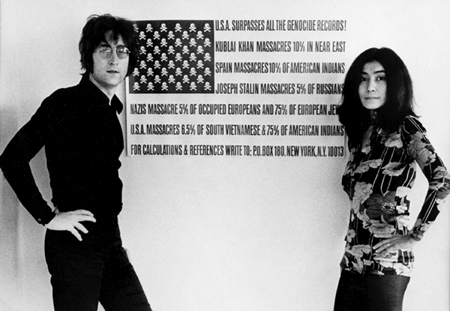FILM-FORWARD.COMReviews of Recent Independent, Foreign, & Documentary Films in Theaters and DVD/Home Video
Written, Produced & Directed by David Leaf & John Scheinfeld. Director of photography: James Mathers. Edited by Peter S. Lynch II. Released by: Lionsgate. Country of Origin: USA. 99 min. Rated: PG-13. Just as John Lennon used the media (and vice versa) to spread his anti-war message, The U.S. vs. John Lennon is clearly the most attention-getting culmination of recent films focusing on the protest movements of the ‘60s: the re-released Winter Soldier (1972) and this year’s Sir! No Sir!, forceful reminders of the strong military opposition to the Vietnam War. With his name recognition and popular music catalogue, the glib star power of the ex-Beatle still shines on. In something of a departure for VH1, which is copresenting the film with Lionsgate, there are no backstage dramas here: The breakup of the Fab Four or Lennon’s rivalry with Paul McCartney is never mentioned. Instead, the first hour’s focus is the conversion of the beloved mop top into a political activist. A large part of the credit here is due to Yoko Ono, who friend Elliot Mintz singles out for helping Lennon find his voice. (This film is not for her detractors.) Besides the news footage of their bed-ins for peace in Amsterdam and Montreal, there are fascinating clips from the couple’s appearance on the urbane Dick Cavett talk show, both smoking cigarettes, and guest-hosting the middle-of-the-road Mike Douglas show. (Their appearances on Cavett’s late night show have been compiled by Shout Factory in The Dick Cavett Show: John & Yoko Collection). It is unlikely today that a reporter for a mainstream news outlet, The New York Times, would attack a celebrity, in this case calling Lennon ridiculous, in a contentious interview before a camera. Although the film does not go into detail into the various anti-war factions, (the Yippies, the Student Mobilization Committee, or the Weathermen), it does note, through Angela Davis, that Lennon sided with nonviolent action for change: “It’s a mistake to think revolutions must be violent.” Although one myth the film perpetuates is Lennon’s working-class status. Although born to a merchant seaman, he was actually brought up by relatives in a middle-class neighborhood in south Liverpool. The last third covers President Richard Nixon’s paranoia of the anti-war movement. In a letter from Strom Thurmond to Nixon, the conservative senator suggests Lennon’s visa should be terminated, which resulted in the law suit referred to in the film’s title. The most chilling moments go to unrepentant Nixon aide G. Gordon Liddy, who describes the five slain Kent State students as smart as geese for not knowing what would happen to them. Even more so than 2002’s The Weather Underground, this film details the Federal government’s campaign against dissent during this time.
Both John Lennon and Sir! No Sir! effectively allow the viewer to make his own comparison and contrast between the
protest movement of 35 years ago and today. Direct examination is for another film. It’s not until the last talking-head interview
with the ubiquitous Gore Vidal (the Maggie Gyllenhaal of political docs) that a heavy-handed comparison between Nixon and George W.
Bush is made. The huge difference between then and now has already been colorfully captured in footage from an era when, according to author Tariq Ali, “The whole culture became radicalized.”
Kent Turner
|
